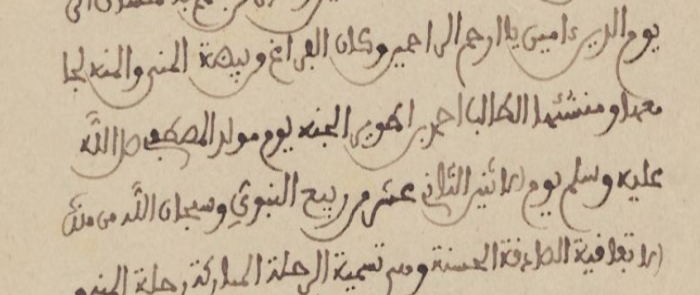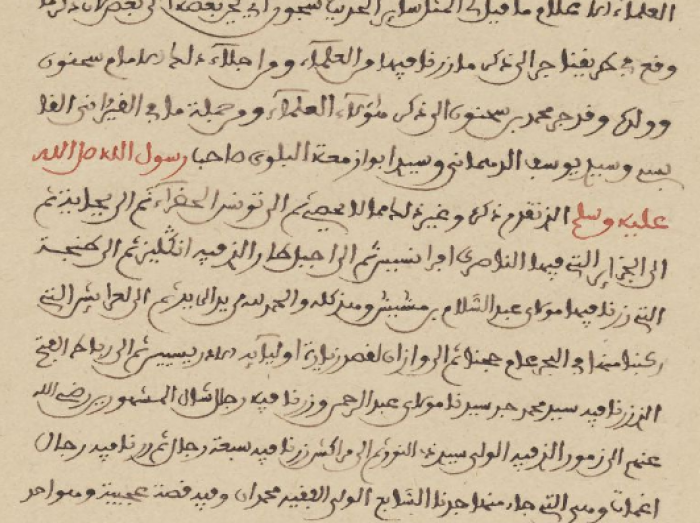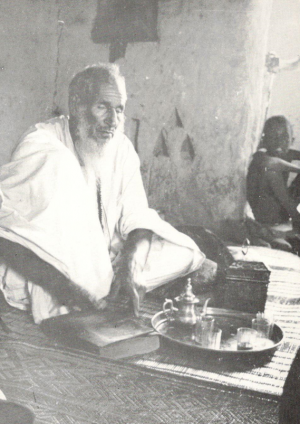About this manuscript
Aḥmad ibn Ṭwayr (or Uṭwayr) al-Janna (ca 1787-1848/9) was born in Wādān, in today’s Mauritania, and died there too. But in between he traveled as a pilgrim and a man of letters in search of knowledge. His fame today is based on this travelogue, The Journey of Hope and Blessings. It is a lively account of a journey along the Mediterranean to Mecca and Medina and back, which took five years, from 1829 to 1834. Ibn Ṭuwayr reports his meetings with holy men, book sellers, scholars and authorities, his visits to saints’ tombs, his observations (favourable) of the English and French (less favourable) whom he met. And he recounts marvellous anecdotes, poems and songs he heard along the way. On f47recto and verso for instance, he noted the text (fully vocalised, because many of the words represent sounds rather than meanings) of a song he heard in Egypt, about a nightingale, صوت صفير البلبلي, which is still well known in Arab countries. It is no wonder that the work soon became popular and was copied many times. (See Rebstock, Sammlung arabischer Handschriften aus Mauretanien. Wiesbaden 1989, p. 129.)

In the colophon on f 75v we read that the collector and author of these travel notes, the searcher of knowledge Aḥmad b. Ṭuwayr al-Janna, finished the manuscript on Monday, 12 Rabiʿ II. A year is not mentioned, but this calender converter tells us that 12 Rabīʿ II fell on a Monday in 1250/1834. That is the year in which he returned from his pilgrimage. Although the colophon says “kān al-farāgh min bayḍa…”, bayḍa in this case does not mean that this is a final version. In the second part the sequence of events is different from that in later versions of the book and the last pages here are just sketches.

See for instance f 71v above, where the author is on his way back and simply notes: Kairouan, then to Tunis, where we met X, to Gibraltar, where we met Y, Tangiers, Algiers, Gibraltar, Bougie (Buḥāyā), Rabat, Zammour - the location of a remarkable tale - then to Marrakesh” etc.

In other versions of the text, these notes have been elaborated and completed with anecdotes, poems and praise for the Moroccon ruler Mulay ʿAbd al-Raḥmān. (Inserting poetry was a method to make a codex more voluminous and entertaining and therefore more costly.) H. T. Norris published a translation of one of the copies, which was made in Wādān in 1838, very likely under Ibn Ṭwayr’s supervision. A picture of that copy, lying unopened in front of a shaykh, shows that it is a hefty volume. In the translation, the section which elaborates the notes in the picture above, takes up about thirty printed pages, more than half of the translated travelogue.
The first part of our manuscript matches that of later versions. And, indeed, it also looks as if it was intended as a fair copy. But somewhere during the last leg of his route Ibn Twayr seems to have decided that he would make a better copy once he arrived back home. From then on he used the paper he had reserved for it only for notes and the ductus of his handwriting became less careful and more difficult to read.
Like Ibn Khaldūn before him, Ibn Ṭwayr knew that even the elaborated text which he later made available to copyists, could still be adapted. In the version Norris translated, Ibn Ṭuwayr gave directions to a possible copyist he might never meet, to do one thing or the other, depending on who would succeed the Moroccan Mulay ʿAbd al-Raḥmān. (Norris p. 137, note 49.)
Literature
H.T. Norris (transl. and ed.), The Pilgrimage of Ahmad Son of the Little Bird of Paradise. An Account of a 19th century Pilgrimage from Mauritania to Mecca. Warminster, 1977. (Photos of the manuscript Norris translated are not available in libraries.)
U. Rebstock, Sammlung arabischer Handschriften aus Mauretanien. Wiesbaden 1989.
Leiden University Libraries has microfilms of two other manuscripts of Riḥlat al-munā wa’l-minna, with shelfnumbers A1648 (Rebstock 1989, no. 1018) and A1649 (Rebstock 1989, no 89).
More about this manuscript: Lesson 10, Imposition and the Maghribi paleography exercise.
Questions
-
Compare the handwriting at the beginning and end of the manuscript. What do you see?
-
Apart from the song about the nightingale, more words in the manuscript are vocalised, for instance on f 17a. What kind of words are these?
Assignments
-
Look at the words that are rubricated. What kind of words were written with red ink in the first part? How did the scribe’s idea to structure the text with this visual means change towards the end of the manuscript?
